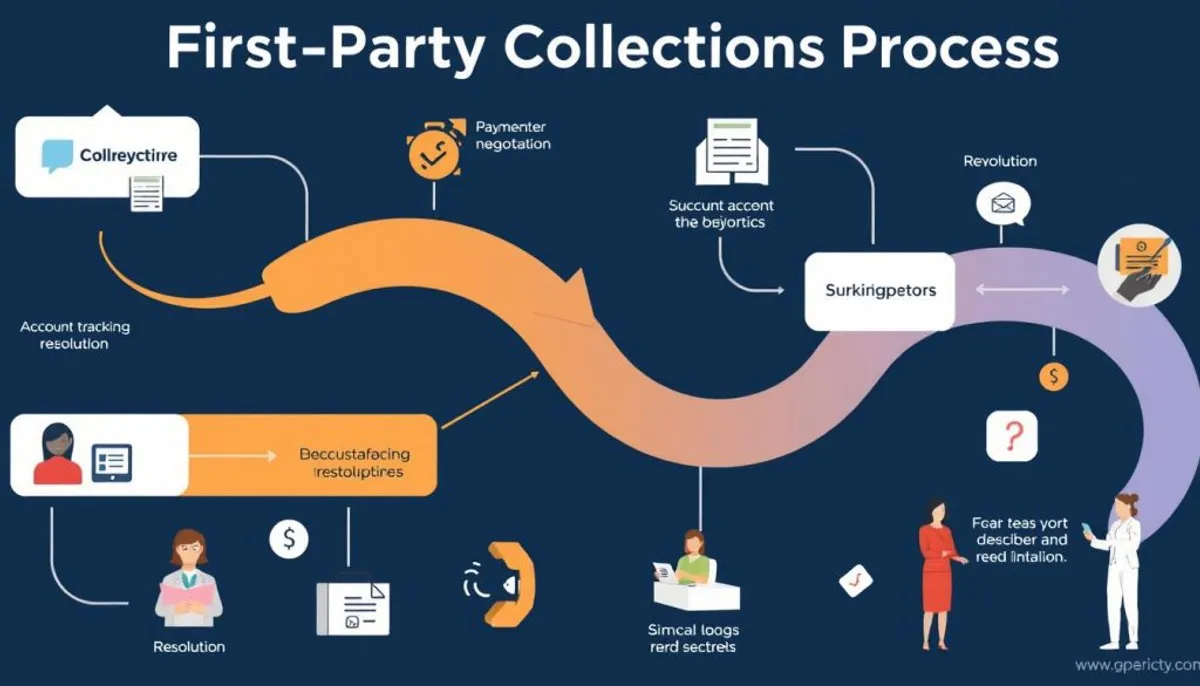Welcome to our comprehensive guide on first party collections and in-house debt recovery. In today’s fast-paced business world, efficiently managing accounts receivable is vital for maintaining a healthy cash flow. This guide will explore the ins and outs of first party collections, offering valuable insights for businesses aiming to streamline their debt recovery processes.

As businesses expand, managing overdue accounts becomes increasingly complex. Many companies initially handle outstanding balances internally, often assigning this task to their Payments or Finance teams. Yet, when these efforts are insufficient, innovative solutions like the ti3 platform emerge. It offers a Software-as-a-Service (SaaS) approach to efficiently manage and resolve unpaid accounts.
In this guide, we’ll dive deep into the world of first party collections. We’ll explore the benefits of keeping debt recovery in-house and introduce cutting-edge tools to optimize your processes. Whether you’re new to accounts receivable management or seeking to enhance your existing strategies, this guide will provide you with the knowledge and tools to thrive in today’s competitive marketplace.
Key Takeaways
- First party collections involve in-house management of overdue accounts
- Efficient debt recovery is crucial for maintaining healthy cash flow
- The ti3 platform offers innovative SaaS solutions for managing unpaid accounts
- In-house collections can be cost-effective for early-stage overdue accounts
- Specialized tools and strategies can significantly improve recovery rates
- Balancing customer relationships with effective debt recovery is essential
Understanding First Party Collections
First party collections are vital in managing past due accounts. This method enables businesses to directly handle consumer collections. It ensures control over customer relationships and the recovery process.
Definition and Core Concepts
In-house collections involve a company’s internal efforts to recover debts before they become severely delinquent. This approach applies to various types of consumer debt, including loans, credit card balances, and medical bills.
Benefits of In-House Collection
Keeping collections in-house offers several advantages:
- Greater control over customer interactions
- Improved success rates for early-stage delinquencies
- Cost-effective compared to third-party agencies
- Preservation of customer relationships
Regulatory Framework
First party collections face less stringent regulations compared to third-party debt collectors. The Fair Debt Collection Practices Act (FDCPA) mainly governs third-party collectors. This gives in-house teams more flexibility in their approach.
| Aspect | First Party Collections | Third Party Collections |
|---|---|---|
| Timing | Before delinquency | After significant delinquency |
| Regulation | Less stringent | Governed by FDCPA |
| Customer Relationship | Maintained | Often strained |
By leveraging innovative solutions like ti3, businesses can enhance their in-house collections strategy. This offers a cost-effective and efficient alternative to traditional debt recovery methods.
The Evolution of Debt Recovery Practices
Debt recovery practices have undergone significant changes over time. In the past, harsh methods like debt slavery and imprisonment were common. During the Great Depression, large financial institutions relied heavily on foreclosures to collect mortgage debts.
Today, the landscape of debt collection looks vastly different. The industry now employs over 140,000 people in the U.S. and recovers more than $50 billion annually. Modern collection agencies use advanced technology to manage delinquent payments efficiently.
The Fair Debt Collection Practices Act of 1977 marked a turning point, aiming to combat abusive practices and protect consumers. This led to more ethical approaches in handling collection efforts.
Recent developments have seen a shift towards in-house collection strategies. Businesses are now exploring cost-effective alternatives to traditional collection agencies. Platforms like ti3 offer automated solutions that streamline the process of managing delinquent payments without relying on external agencies.
| Aspect | Past | Present |
|---|---|---|
| Methods | Debt slavery, imprisonment | Technology-driven, ethical approaches |
| Regulations | Limited | FDCPA, state regulations |
| Tools | Manual processes | Automated platforms, AI |
| Focus | Punitive measures | Customer relationship management |
This evolution reflects a growing emphasis on fair practices, consumer protection, and efficient debt recovery strategies in the modern financial landscape.
Key Components of Successful In-House Collections
Effective in-house collections depend on several critical elements. These components work together to form a robust first-party collection strategy. Let’s explore how they contribute to success.
Staff Training Requirements
Well-trained staff are essential for successful collections. Employees must possess negotiation, conflict resolution, and empathy skills. Regular training on handling past due accounts and making collection calls is crucial.
Technology Infrastructure
Modern collection efforts require a robust technology infrastructure. Platforms like ti3 streamline processes by automating dunning letters and issue escalation. This technology aids in managing increasing account volumes without the need for additional staff.
Communication Protocols
Clear protocols are necessary for effective interactions with debtors. These include guidelines for sending dunning letters, making collection calls, and offering payment plans. Balancing persistence with respect is key to maintaining positive customer relationships.
Performance Metrics
Tracking key performance indicators is vital. Metrics such as recovery rates, average collection time, and customer satisfaction scores are important. Regular analysis helps refine collection strategies.
| Component | Impact on Collections |
|---|---|
| Staff Training | Improves negotiation skills and compliance |
| Technology | Automates processes and increases efficiency |
| Communication | Enhances debtor engagement and recovery rates |
| Performance Metrics | Guides strategy refinement and goal setting |
By focusing on these key areas, businesses can establish a strong in-house collection system. This approach effectively manages past due accounts while preserving positive customer relationships.

Building an Effective Collection Strategy
Developing a successful accounts receivable strategy necessitates a harmonious blend of assertiveness and empathy. To enhance recovery rates and preserve positive client relationships, businesses must adopt a strategic approach towards handling delinquent payments.
Initiating consumer collections early on is paramount. Research indicates that companies frequently delay action until invoices are overdue. A proactive strategy entails contacting clients 7-10 days prior to the due date, significantly enhancing the likelihood of timely payments.
Optimizing billing cycles can expedite the collection process. Transitioning from bi-monthly to weekly invoicing facilitates the detection of payment runs and minimizes delays. For accounts that are overdue, prompt follow-up within a week is essential to secure commitments and understand the reasons behind delays.
- Offer diverse payment options to ease the process
- Build relationships with accounts payable managers
- Train collection specialists for improved effectiveness
Integrating technology into your strategy is indispensable. Platforms like ti3 automate reminders and offer multi-channel communication tools. These tools preserve the personal touch crucial in first-party collections while enhancing efficiency.
| Generation | Average Total Debt | Key Collection Strategy |
|---|---|---|
| Gen Z (18-26) | $29,820 | Text messaging, email |
| Millennials (27-42) | $125,050 | Digital communications |
| Gen X (43-58) | $157,560 | Personalized outreach |
| Baby Boomers (59-77) | $94,880 | Traditional phone calls |
By customizing your strategy to cater to different age groups and leveraging digital strategies, you can significantly reduce collection costs to as low as 3%. This approach also helps in maintaining robust customer relationships.
ti3 Platform: Modernizing First Party Collections
The ti3 platform is a game-changer for in-house collections, offering a comprehensive solution for managing past due accounts. It streamlines debt recovery processes, enhancing efficiency and effectiveness for businesses of all sizes.
Platform Overview
ti3 seamlessly integrates with existing systems, providing a user-friendly interface for managing debt recovery tasks. It offers a suite of features designed to optimize collection efforts while maintaining positive customer relationships.
Automated Payment Reminders
The platform’s automated reminder system reduces manual workload and improves consistency in communication. It sends timely, personalized reminders to customers with past due accounts, increasing the likelihood of prompt payments.
Customer Communication Tools
ti3 provides multi-channel outreach capabilities, enabling personalized communication via email, SMS, and voice calls. These tools ensure professional and compliant interactions with customers, fostering positive relationships throughout the collection process.
Analytics and Reporting Features
Robust analytics and reporting tools offer valuable insights into collection performance. These data-driven features help businesses refine their in-house collections strategies, leading to improved recovery rates and operational efficiency.
| Feature | Benefit |
|---|---|
| Automated Reminders | 30% increase in on-time payments |
| Multi-channel Communication | 25% improvement in customer engagement |
| Analytics and Reporting | 20% boost in overall collection efficiency |
Legal Compliance and Best Practices
Understanding the legal framework of consumer collections is essential. It involves grasping regulations and best practices. For entities involved in first party collections, adherence to these standards is paramount. It prevents hefty fines and upholds ethical conduct.
FDCPA Guidelines
The Fair Debt Collection Practices Act (FDCPA) establishes the ethical norms for debt collection. Primarily aimed at collection agencies, its principles are widely adopted by first party collectors as industry benchmarks. The FDCPA bars harassment and restricts communication to 8 a.m. to 9 p.m. in the debtor’s local time.
State Regulations
State laws introduce additional intricacies to the recovery of delinquent payments. Each jurisdiction has its own set of rules for consumer collections. It is imperative for businesses to keep abreast of these regulations. The ti3 platform aids in this endeavor by integrating state-specific compliance features.
Documentation Requirements
Accurate documentation is vital in debt collection. Collectors must record all interactions and agreements meticulously. The ti3 platform automates these tasks, reducing the likelihood of errors and ensuring compliance with documentation mandates.

By following these guidelines and utilizing technology like ti3, businesses can manage first party collections effectively. This strategy minimizes legal risks while respecting consumer rights. It fosters more positive relationships with debtors.
Maximizing Recovery Rates Through Technology
Technology has transformed the landscape of accounts receivable management and debt recovery. Modern solutions have streamlined processes, enhanced efficiency, and significantly improved recovery rates for past due accounts.
Digital Payment Solutions
Digital payment tools introduce various options for settling debts, enhancing debtor engagement and accessibility. The inclusion of real-time payment features facilitates instant account settlement, thus improving cash flow. The user-friendly interfaces of these systems contribute to higher repayment rates.
Account Management Tools
Advanced account management tools offer a comprehensive view of each account, enabling more strategic collection efforts. Data analytics facilitate the prioritization of accounts based on recovery likelihood. Predictive analytics identify high-risk accounts, allowing for focused attention to reduce charge-offs.
Automation Benefits
Automation streamlines workflows and minimizes human error, enabling teams to concentrate on high-value activities. Automated reminders ensure timely follow-ups for upcoming or overdue payments, enhancing repayment likelihood. Personalized communication, facilitated by advanced analytics, improves resolution chances with debtors.
| Technology Feature | Benefit |
|---|---|
| Digital Payment Options | Increased debtor engagement |
| Data Analytics | Better account prioritization |
| Automated Reminders | Improved repayment rates |
| User-friendly Interfaces | Higher customer satisfaction |
By embracing these technological advancements, organizations can significantly enhance their collection efforts and improve their bottom line. The ti3 platform exemplifies the transformative power of integrated technology in first-party collections. It combines automated reminders, intelligent customer segmentation, and data-driven insights to boost recovery rates while maintaining positive customer relationships.
Customer Relationship Management in Collections
In the realm of consumer collections, fostering positive customer relationships is paramount. The in-house approach allows for a more personalized interaction, potentially safeguarding customer loyalty. The ti3 platform further enhances this endeavor by facilitating empathetic dialogue and offering adaptable payment solutions.
Effective customer relationship management in collections necessitates a delicate balance between debt recovery and customer satisfaction. Leveraging technology to deliver superior service can transform potentially negative interactions into opportunities for relationship enhancement.
The ti3 platform’s automated communication tools have notably boosted recovery efficiency. Some entities have witnessed a 35% rise in recovery rates. Self-service payment portals have also contributed to a 30% increase in recovery rates, enhancing debtor convenience.
Predictive analytics have led to a 25% increase in the prioritization of high-risk accounts, fostering a more focused collection strategy. This data-driven methodology aids in preserving positive client relationships throughout the collection process.
| Technology Feature | Impact on Collections |
|---|---|
| Automated Communication Tools | 35% improvement in recovery rates |
| Self-Service Payment Portals | 30% increase in recovery rates |
| Predictive Analytics | 25% increase in high-risk account prioritization |
| Mobile Accessibility Tools | 40% increase in communication frequency |
By harnessing these technologies, companies can refine their in-house collections processes while preserving customer relationships. The integration of dunning letters with these digital tools forms a holistic strategy for debt recovery. This approach ensures both efficiency and customer care are prioritized.
Conclusion
First party collections are crucial for financial health and building strong customer relationships. The debt recovery field is rapidly changing, with new technologies transforming how collections are handled. The ti3 platform is a significant advancement, offering cutting-edge solutions for managing accounts receivable.
Adopting a technology-driven approach to first party collections can yield remarkable outcomes. Research indicates that using first-party data for targeting can increase customer lifetime value by 68%. First-party data-driven campaigns also see a 60% conversion rate, compared to 2% for non-data-driven efforts.
Embracing advanced solutions like ti3 offers more than just better recovery rates. With 87% of marketers seeing first-party data as essential for personalized experiences, platforms that focus on customer communication and data analytics are invaluable. Ti3’s automated payment reminders and detailed reporting features are in line with this trend, aiding in compliance and enhancing customer loyalty.
When assessing your current collection methods, consider how ti3 could revolutionize your accounts receivable management. With 83% of companies surpassing revenue goals through first-party data strategies, the growth potential is evident. Choosing ti3 for your debt recovery needs not only boosts your profits but also places your business at the leading edge of an evolving industry.
RelatedRelated articles



